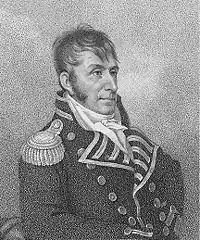Jacob Jones | |
|---|---|
 Commodore Jones | |
| Born | March 1768 Smyrna, Delaware Colony, British America |
| Died | August 3, 1850 (aged 81–82) Philadelphia, Pennsylvania, US |
| Buried | Wilmington and Brandywine Cemetery, Wilmington, Delaware, US |
| Allegiance | United States |
| Service/ | United States Navy |
| Years of service | 1799–1850 |
| Rank | Commodore |
| Commands held |
|
| Battles/wars |
|
Commodore Jacob Nicholas Jones (March 1768 – August 3, 1850) was an officer in the United States Navy during the Quasi-War with France, the First Barbary War, the Second Barbary War, and the War of 1812.
Biography
Jones' birthplace was on a farm about one mile northwest of the town of Smyrna, Delaware. His father was a farmer of exemplary moral and religious character and his mother was of a family greatly respected. She died when he was an infant. His father soon followed her to the grave and at four years of age he was an orphan. It is not clear how he became a doctor. Educated in medicine and practicing as a doctor, he was later appointed as Clerk of the Delaware Supreme Court. He was married to Anna Matilda Sykes, daughter of James Sykes the 15th Governor of Delaware; she died before he joined the United States Navy.[1]
Midshipman
Jones joined the United States Navy in 1799 at the age of 31, very old for the times, when a midshipman could be as young as 10. Some think he joined the Navy because of grief after the death of his wife. He spent 22 months as an acting midshipman.
Lieutenant
During the Quasi-War with France, he served under Commodore John Barry in the frigate United States and was commissioned a lieutenant February 27, 1801. Jones joined the crew of Philadelphia on May 24, 1803, as second lieutenant (2nd mate). On October 31, 1803, he was taken prisoner with the rest of Philadelphia's crew by the Bey of Tripoli and held until liberated in June 1805.
Master Commandant
On April 20, 1810, Jones received promotion to master commandant, and on June 4, he took command of USS Wasp. In October 1812, Jones and Wasp sailed on an Atlantic cruise. On October 13 he captured the British 12-gun brig HMS Dolphin.
Despite storm damage to his ship, he attacked a British convoy on October 18 and, following an intense battle, captured the Royal Navy sloop of war HMS Frolic, in a battle that became quite famous. Both combatants were seriously damaged and he soon fell victim to the powerful ship of the line HMS Poictiers. Still, Jones was widely admired and when he returned to the United States after an exchange of prisoners, he received a gold medal from the United States Congress.
Captain
Jones was promoted to the rank of captain in March 1813 and given command of the frigate USS Macedonian. He spent time in Decatur's squadron, which was bottled up at New London during 1814. Later, Captain Jones was sent to the Lake Ontario theater, where he commanded the frigate USS Mohawk during the last year of the war.
During the second and final Barbary War, in 1815, Jones again commanded Macedonian. Service as captain of the frigate USS Guerriere followed in 1816–1818.
Commodore
Jones was Commodore of the United States' squadrons in the Mediterranean in 1821–1823 and in the Pacific in 1826–1829. He was a Navy Commissioner in Washington, DC, between those tours at sea and held important commands ashore at Baltimore and New York during the 1830s and 1840s. He received his final assignment, as commandant of the Philadelphia Naval Asylum in 1847. Commodore Jacob Jones held that position until his death.
Death and legacy

Jones died on August 3, 1850, and is interred at the Wilmington and Brandywine Cemetery in Wilmington, Delaware.[2]
Three ships, USS Jacob Jones, have been named for him. Jones Island of Washington state is also named for Jones.[3]
References
- ↑ Cleaver, Mark M. (1906). The Life, Character, and Public Service of Commodore Jacob Jones. Wilmington, Delaware: The Historical Society Of Delaware. OL 7087183M.
- ↑ "Jacob Nicholas Jones". www.findagrave.com. Retrieved August 16, 2019.
- ↑ Majors, Harry M. (1975). Exploring Washington. Van Winkle Publishing Co. p. 14. ISBN 978-0-918664-00-6.
- This article incorporates text from the public domain Dictionary of American Naval Fighting Ships. The entries can be found here and here.
External links
- "Jacob Jones". Find a Grave. Retrieved March 31, 2008.
- NHC Biography and Photographs